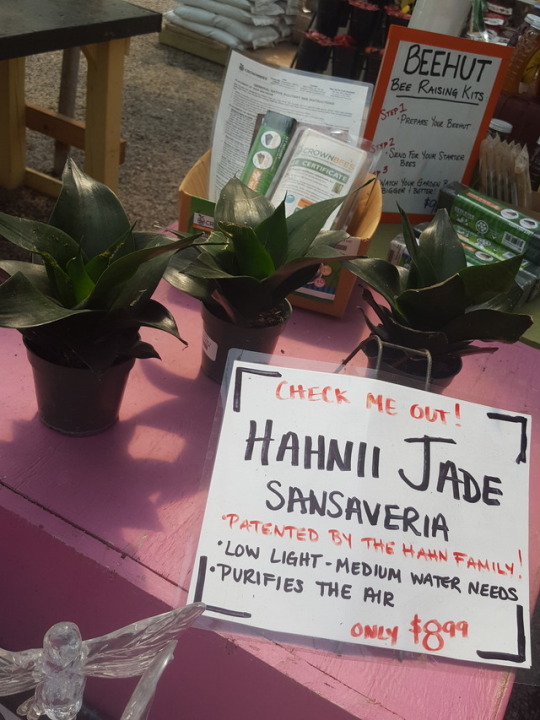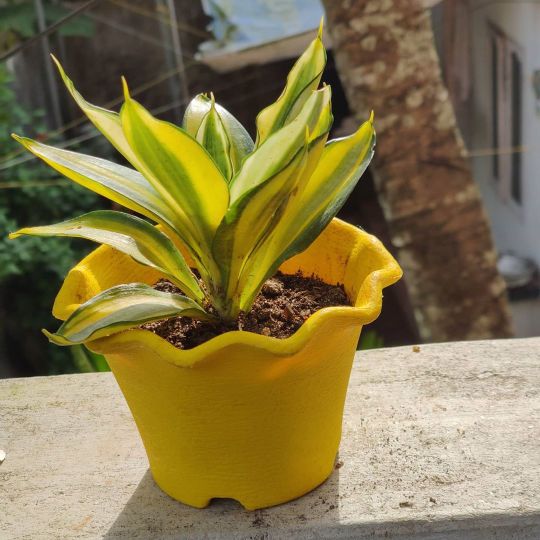#sanseveria trifasciata
Text
Sansevieria trifasciata Laurentii
De Vrouwentong, zoals de Sanseveria, ook wordt genoemd, is klassiek, maar ook hip en stijlvol. Een echte aandachttrekker.
Het bericht Sansevieria trifasciata ‘Laurentii’ verscheen eerst op De Kamerplanten Shop.
https://ifttt.com/images/no_image_card.png
https://kamerplanten.shop/kopen/sansevieria-trifasciata-laurentii/
#kamerplanten#kwekerijen#telers#dagverse#kopen#flora#rechtstreeks#plantensoorten#bloemen#verzendkosten#éénaankoop#één#webshop#aanbod#ongetwijfeld
0 notes
Text
Snake Plant Care | Best Tips To Grow Sansevieria

Snake plants, a.k.a Sanseveria (Dracaena trifasciata - scientific name) are some of the easiest houseplants to grow and care for in your backyard, balcony, or room. These easy-care plants originally grow in Africa.
In the Netherlands, they are known as women's tongue, and in Belgium as the widow's tongue. The plant family is called Agavaceae. Here are some informative tips to grow Snake plants.
Here you will find all the details about snake plant care. Keep reading for the optimum Sansevieria care tips, light, and growth conditions.
Sansevieria watering
Snake Plant (Sansevieria) uses very little water. The only way to kill a Sansevieria is to give the plant too much water. It is, therefore, better not to pour when in doubt. It is essential that all of the soil is dry before the Sansevieria gets fresh water. Otherwise, root rot occurs quickly.
You might also like: Flowering hedges: 12 Best hardy hedge plants with flowers
In winter, the Sansevieria can do without water for a good 6 to 8 weeks. During the growing season in spring and summer, it is advisable to water once every two weeks. During a hot spell, the Sansevieria can take an extra portion of water.
The amount of water depends, among other things, on the size of the pot and the light intensity. The larger the pot, the more water the bottom can hold. Besides, Sansevieria needs 2-3 times more water in front of a window in the south than a plant in front of a window in the north. If the soil still feels quite damp after days, give less water.
Spraying
The Sansevieria gets along perfectly with dry air. Spraying is therefore not necessary. However, it can be used to remove and avoid dust on the leaves.
Sansevieria light and warmth
The Sansevieria does not have high demands on light intensity. If the plant is placed closer to a window, the color of the leaf will fade a little. The Sansevieria Black Coral, therefore, stays much nicer if it stands further away from the window.
If the Sansevieria is further away from the frame, the water requirement should undoubtedly decrease, and the growth is delayed somewhat. We do not recommend a distance of more than 4 meters from the window.
You can find intelligent plant sensors with solar cells and WiFi connections for easy maintenance at our gardener store. These sensors show the light value, temperature, and humidity of the soil.
Minimum temperature requirement
- During the day: 59.00 °F (15 ℃)
- At night: 37.40 °F (3 ℃)
Repotting Sansevieria
The Sansevieria is also an easy-care houseplant when it comes to repotting. Repotting a snake plant can be done immediately after purchase, but even if the Sansevieria has outgrown the current pot after about 1-3 years. A few damaged roots won't do much harm to a Sansevieria.
Use an ornamental pot that is at least 20% wider than the previous one. Use universal potting soil or cactus soil. Add expanded clay if there is a drainage hole.
Sansevieria fertilizing
A Sansevieria grows slowly and therefore needs little fertilizer. Only give a small amount of liquid fertilizer in spring or summer. About ¼ of the amount stated on the packaging is sufficient. Alternatively, use cactus fertilizer.
Snake Plant Care | How to care for Sansevieria?
Discolored leaves
The Sansevieria becomes darker when it is further away from the window and lighter when it is closer to the window. Both places are fine for the plant.
Cutting
A sansevieria cannot be cut. The growth would then stop. In general, Sansevierias do not grow taller than 150 cm. If the houseplant gets too big, the best way to remove the largest leaves is to cut them off at the bottom. Cutting on half the sheet is possible, but not always lovely. Brown spots can be cut away.
Breed
Propagation is possible by sticking or tearing. When torn, the color is retained. When sticking with brightly colored specimens, the plant will grow more significantly than a green sample.
Sansevieria blooming
The Sansevieria can flower as a houseplant. However, it is better to prevent this to save the plant's energy. The flowers can give off a sweet smell.
Toxicity
Sansevierias are slightly poisonous. Make sure that children or animals do not eat from it. This can lead to gastrointestinal problems.
Snake Plant diseases
The Sansevieria is seldom afflicted by the disease. A hard jet of water can easily remove any lice from the hard leaves.
https://www.youtube.com/embed/8xdygwy6qho
FAQ - Snake Plants
Is Snake Plant Dangerous For Cats?The question "Is snake plant flowers and leaves dangerous for cats?" is frequently asked by many pet owners and keepers. Snake plant, or Hyoscyamus Niger in botanical language, often grows in floodplains, swamps, marshes, and near creeks. A Snake plant, especially the variegated kind, is most often seen growing in houses, backyards, and parks.The answer to this is yes; when consumed by cats, snake plants can be poisonous.It contains some mild toxins in the form of alkaloids and saponin; this is why it can potentially be hazardous to your cat, thus, not safe for him. However, this said, the problem doesn't exist because there aren't any reported cases of snake plant poisoning that is harmful to your cat or humans.These plants are indeed very toxic to animals, but they do not pose a significant threat to our health when you eat them. It should be noted, though, that if a cat has ingested a Snake plant and has stomach or intestinal irritation, this is considered a symptom indicating that the plant has probably caused or aggravated an existing condition or disease.If this is the case, your cat should be evaluated immediately for a full course of medication for a possible secondary infection or more advanced conditions such as intestinal cancer. In most cases, though, Snake plant poisoning will only cause mild irritation or mild stomach upset for your cat.Should I mist my snake plant?Desert plants that thrive in high temperatures and high levels of humidity are known as snake plants. In light of the aforementioned, it is important to note that it is typically not advised to spray the leaves of a snake plant. The leaves of the snake plant may get overwatered if they are sprayed with water, which can then lead to a variety of additional health problems.Can snake plants live in no light?Yes. It is possible for it to live without sunshine, but only for a limited amount of time. As was just discussed, in order to manufacture their food via the process of photosynthesis, all green plants need exposure to sunlight. The other side of the coin is that snake plants can really continue to live for a very long time (even when they are not exposed to any sunlight at all), provided that they have access to grow lights.How do I know if my snake plant is healthy?If you want to know whether or not your sansevieria is healthy, look for leaves that are a dark green color. The presence of dark leaves on a snake plant is a sign that the plant is healthy and receiving enough nutrition. Dying plants sometimes have leaves that have a yellowish tint on the outer edge of the leaves or leaves that are pale and floppy. If you see any of these symptoms, it may be time to get rid of the plant.How do I increase my snake plant growth?It is important to choose an appropriate container for your snake plant, supply it with the appropriate quantity of water, ensure that it receives a great deal of sunshine, fertilize it on a consistent basis, and be vigilant for any signs of insect infestation. Your snake plant will be able to grow green leaves if it receives an adequate quantity of strong light and a modest bit of fertilizer.When should you repot a snake plant?Late winter or early spring is the time of year that is ideal for repotting your indoor plant. The fact that your plant is in a dormant state throughout the winter and that it is just before the busy growth season (Spring) makes this the ideal time to do the procedure.
Read the full article
0 notes
Text

sansevieria and sunset
59 notes
·
View notes
Text

300320
#sweden#canon#canon eos 70d#team canon#canon forever#canon photography#canon sweden#mars#sansevieria#sanseveria trifasciata#houseplants#green#svärmorstunga
2 notes
·
View notes
Photo


16 notes
·
View notes
Text
Plants just make me really happy.
#secretly multiplying my mother's plants as you read this#my babies now! muhahaha#she has such a beautiful sanseveria trifasciata which is almost breaking the pot#but she'll have to wait till tomorrow since it's raining
4 notes
·
View notes
Text
Because my family always had one, I never really paid attention to sanseverias (Various Dracaena spp., but usually D. trifasciata) and thought they were boring, but now I’ve grown an appreciation for them. I like their very satisfyingly bulky leaves.
Do folks have plants they initially ignored (usually due to seeing them constantly) that they’ve developed a fondness for later?
#I grew up with a Schlumbergera as well (quite literally)#but i grew to like those too! a cutting from the one almost as old as I am lives with me#poaceae are still boring though :P I only take interest in them as far as food goes
9 notes
·
View notes
Text
Why should you get a succulent?

Succulents are plants that are able to retain water in various structures, such as thick fleshy leaves or stems. There are plenty of succulents types and here are some examples:
Sanseveria trifasciata
Echeveria elegans
Haworthia fasciata
Lophophora williamsii
Gymnanocalycium mihanovichii
Opuntia microdasys
Echinocactus grusonii
Peperomia graveolens
Cephalocerus senilis
And what are the advantages of growing a succulent?
They are low-maintenance. It is really hard to kill a succulent, because it stores water very well. But it is important to make sure water can drain out of the pot or container, otherwise the succulent will get overwatered. They are also
You can regrown it. Fully-formed and rooted mini-plants can grow independently at your plant. But also you can plant a new succulent from a cut leave.
A very good decoration. They look interesting and they are a nice topic to talk about with friends or visitors, because they attract attention. I personally really enjoy watching them.
They come in all sorts of colors, shapes and sizes. You can find anything you want looking for a succulent.
They are perfect for small places and people who are busy durning the day, for example for collage students.
They refresh air even through the night. Durning the process of photosynthesis plants release oxygen at day but most of them release carbon dioxide at night. Succulents keep producing oxygen all night so you can sleep well while...
... they are cleaning the air. They are able to remove toxins from air. According to scientific research they can lower the VOC for about 87%.
They help you recover. They can contribute to reducing headaches, fever or cough, lower blood pressure and heart rate. Also they helps you to focus and experience less anxiety.

Today I bought a new succulent. It is called echeveria ‘perle von nurnberg’ and it is blue and purple. I love it already 💜
#succulent#succulents#cactus#plant#indoor plant#save the earth#save the environment#anxiety#stress#tip#potplant#my plant#new plant#eco#ecofriendly#eco-friendly#ecology#ecology blog#leaves#overwatered#sanseveria#snake plant#echeveria#opuntia#flower#peperomia#echinocactus#cactuses#perle von nurnberg#blue and purple
39 notes
·
View notes
Text
i just wanted to make a list of all my plants since im gonna give em all little nametags soon as the stickers i ordered arrive and i know ill forget if i dont write it down somewhere. its long as hell so im cutting it lmfao
-foliage-
Egg - boston fern (nephrolepis exaltata)
Squiggles - curly-locks fern (nephrolepis exaltata ‘emina’)
Stanley - zz plant (zamioculcas zamiifolia)
Gertrude - polka dot begonia (begonia maculata variegata)
-carnivorous plants-
Audrey - 'pink venus’ venus flytrap (dionaea muscipula var. ‘pink venus’)
Varker - unidentified venus flytrap (dionaea muscipula var. unknown)
Ripley - purple pitcher plant (sarracenia purpurea ssp. purpurea)
Mary Mary - pygmy sundew (drosera callistos ‘brookton large form’)
Josie - leaden bladderwort (utricularia livida)
Ania - unidentified cape sundew (drosera capensis var. unknown) [sharing pot with josie]
Shaw - forked-leaf sundew (drosera binata var. ‘small red’) [sharing pot with ripley]
-succulents and cacti- (won’t be naming these guys cuz i have too goddamn many oops)
lithops sp., various seedlings
kalanchoe tomentosa
sanseveria trifasciata var. ‘sunrise’
sedum rubrotinctum var. ‘aurora’
sedum burrito
echeveria sp. ‘purple pearl’
haworthia magnifica
adromischus cristatus
sedeveria letizia
opuntia quimilo
echeveria ‘princess lace’
7 notes
·
View notes
Text

Oh apparently the one greenhouse near me is owned by the family that initially bred Sanseveria trifasciata 'Hahnii' so chances are if you've got a birds nest type snake plant, it's likely it descended from their plants
38 notes
·
View notes
Photo

Painting snake plant leaves(Sanseviera trifasciata) Also testing how the new algorithm works (?) Can you see this on you timeline? Let me know! . . #watercolor #sanseveria #botanicalillustration #painting #friday (at Milan, Italy) https://www.instagram.com/p/Bp-RQQ-nvQ9/?utm_source=ig_tumblr_share&igshid=1416mgihzqvil
1 note
·
View note
Text
Sansevieria trifasciata ‘Laurentii’
De Vrouwentong, zoals de Sanseveria, ook wordt genoemd, is klassiek, maar ook hip en stijlvol. Een echte aandachttrekker.
Het bericht Sansevieria trifasciata ‘Laurentii’ verscheen eerst op De Kamerplanten Shop.
https://ifttt.com/images/no_image_card.png https://kamerplanten.shop/kopen/sansevieria-trifasciata-laurentii/
View On WordPress
#aanbod#één#éénaankoop#bloemen#dagverse#flora#kamerplanten#kopen#kwekerijen#ongetwijfeld#plantensoorten#rechtstreeks#telers#verzendkosten#webshop
0 notes
Text
Decorum Sansevieria Laurentii XL met Elho B.for soft antracite
Decorum Sansevieria Laurentii XL met Elho B.for soft antracite
Plant Decorum Sanseveria
De Plant Decorum Sanseveria wordt ook wel vrouwentong genoemd. Het is een onverwoestbare krachtpatser en bovendien een heuse comeback kid. Want de Sansevieria is weer helemaal hip! Dit is een cultivar of variant van de Sanseveria Trifasciata die werd geïntroduceerd door Emile Laurent. Hij lijkt veel op de Sanseveria Trifasciata maar heeft met de gele randen veel meer…

View On WordPress
0 notes
Photo

☘️ Sansevieria trifasciata 'Golden Hahnii' ☘️My favourite varient if the Snake plant / Sanseveria. Info: The Golden Hahnii Sanseveria is a beautifully variegated very dwarf and compact evergreen with boldly variegated bright yellow and green foliage. The thick succulent foliage naturally develops into a bird-nest like shape with leaves that rarely exceed 4-6" long. This makes a perfect low maintenance indoor or patio container plant. Soil: Provide the Golden Hahnii Sanseveria with a well-drained soil and allow the soil to become moderately dry between waterings. Also known as: golden hahnii, sansevieria gold hahnii, golen birds nest sansevieria, snake plant. . . . . . . . . . . #snakeplant #plants #sansevieria #indoorplants #houseplants #plantsofinstagram #succulents #plantsmakepeoplehappy #cactus #plantlover #homedecor #plant #houseplantsofinstagram #aloevera #snakeplants #urbanjungle #plantlife #houseplant #motherinlawstongue #houseplantclub #plantstagram #cacti #snakesofinstagram #goldenhahnii #sansevierialovers https://www.instagram.com/p/CEygAB1g_-Z/?igshid=xvi6pxp64kct
#snakeplant#plants#sansevieria#indoorplants#houseplants#plantsofinstagram#succulents#plantsmakepeoplehappy#cactus#plantlover#homedecor#plant#houseplantsofinstagram#aloevera#snakeplants#urbanjungle#plantlife#houseplant#motherinlawstongue#houseplantclub#plantstagram#cacti#snakesofinstagram#goldenhahnii#sansevierialovers
0 notes
Note
Sanseveria trifasciata is also called Saint George's Sword plant. Incredibly how many names it can have!
She's gorgeous!
0 notes
Photo

86 notes
·
View notes